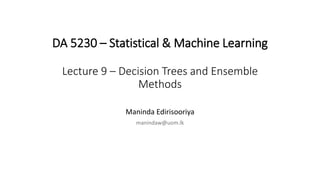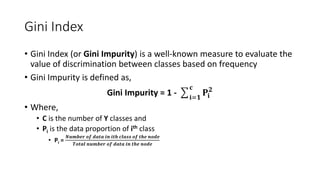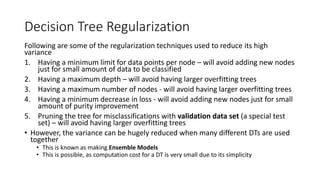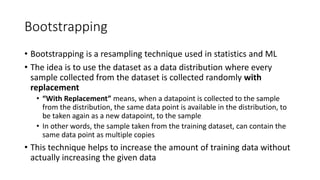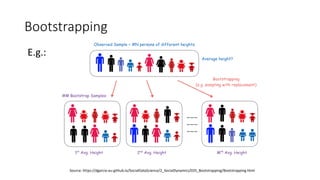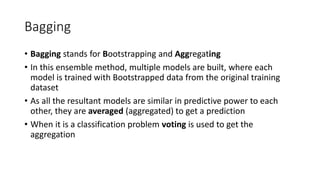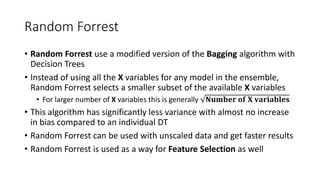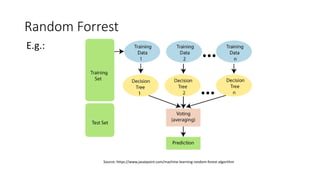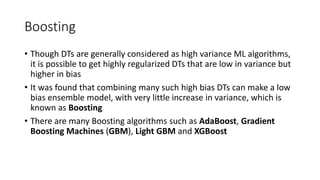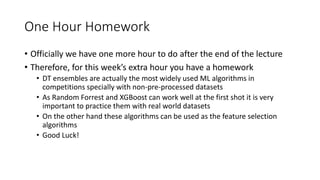Lecture 9 - Decision Trees and Ensemble Methods, a lecture in subject module Statistical & Machine Learning
- 1. DA 5230 – Statistical & Machine Learning Lecture 9 – Decision Trees and Ensemble Methods Maninda Edirisooriya manindaw@uom.lk
- 2. Decision Tree (DT) • Tree-like ML modelling structure • Each node is relevant to a categorical feature and branch to classes of that feature • During prediction, data is moved from root and passed down till it meets a leaf • Leaf node decides the final prediction BMI > 80 Age > 35 Smoking Vegetarian Exercise True False True False Cardiovascular Disease Predictor Root Node Internal Node Leaf Node Disease Healthy Disease Healthy Disease Healthy True False True False True False
- 3. Decision Trees • Suppose you have got a binary classification problem with 3 independent binary categorical variables X1, X2, X3, and 1 dependent variable Y • You can draw a decision tree starting from one of the X variables • If this X variable cannot classify the training dataset perfectly, add another X variable as a child node to the tree branches where there are misclassifications (or not Pure) • Even after adding the second X variable, if there are some misclassifications in the branches, you can add the third X variable as well OR you can add the third variable as the second node of the root
- 4. Decision Trees You will be able to draw several trees like that, depending on the training set and the X variables (note that outputs are not shown here) Depth 1 Root X1 X2 X3 Depth 1 Root X1 X2 Depth 2 Depth 1 Root X1 X2 X3 Root X1
- 5. Optimizing Decision Trees • In order to find the maximum Purity of the classification you will have to try with many decision trees • As the number of parameters (nodes and their classes) are different in each of the decision tree, there is no optimization algorithm to minimize the error (or impurity) • Known algorithms to find the globally optimum Decision Tree are computationally expensive (problem known as a NP-hard Problem) • Therefore, heuristic techniques are used to get better performance out of Decision Trees
- 6. CART Algorithm • CART (Classification And Regression Tree) is one of the best heuristic Decision Tree algorithms • There are 2 key decisions to be taken in the CART algorithm 1. How to select the X variable to be selected to split on each node? 2. What is the stopping criteria of splitting? • Decision 1 is taken based on the basis of maximizing the Purity of classification on the selected node • Decision 2 is taken based on the basis either on, • Reduction of purity added with new nodes • Increased computational/memory complexity of new nodes
- 7. Stopping Criteria of Splitting Splitting to a new node (being a leaf node) can be stopped with one of the following criteria • When all the data in the current node belongs to a one Y class • Adding a new node exceeds the maximum depth of the tree • Impurity reduction is less than a pre-defined threshold • Number of data in the current node is lesser than a pre-defined threshold
- 8. Adding a New Node (Splitting) • A new node is added to a tree node, only when that branch has data belongs to more than a one Y class (i.e. when impurity is there) • When a new node is added, the total impurity of the new node branches should be lesser than the current node • Therefore, the new node is selected which has the capability of increasing the purity (or reducing the impurity) as much as possible • There are mainly 2 measurements to evaluate the impurity reduction, 1. Gini Index 2. Entropy 3. Variance (in Regression Trees)
- 9. Gini Index • Gini Index (or Gini Impurity) is a well-known measure to evaluate the value of discrimination between classes based on frequency • Gini Impurity is defined as, Gini Impurity = 1 - 𝐢=𝟏 𝐜 𝐏𝐢 𝟐 • Where, • C is the number of Y classes and • Pi is the data proportion of ith class • Pi = 𝑵𝒖𝒎𝒃𝒆𝒓 𝒐𝒇 𝒅𝒂𝒕𝒂 𝒊𝒏 𝒊𝒕𝒉 𝒄𝒍𝒂𝒔𝒔 𝒐𝒇 𝒕𝒉𝒆 𝒏𝒐𝒅𝒆 𝑻𝒐𝒕𝒂𝒍 𝒏𝒖𝒎𝒃𝒆𝒓 𝒐𝒇 𝒅𝒂𝒕𝒂 𝒊𝒏 𝒕𝒉𝒆 𝒏𝒐𝒅𝒆
- 10. Entropy • Entropy is a measure of randomness or chaos in a system • Entropy is defined as, Entropy = H = - 𝐢=𝟏 𝐜 𝐏𝐢 𝐥𝐨𝐠𝟐(𝐏𝐢) • Where, • C is the number of Y classes and • Pi is the data proportion of ith class • Pi = 𝑵𝒖𝒎𝒃𝒆𝒓 𝒐𝒇 𝒅𝒂𝒕𝒂 𝒊𝒏 𝒊𝒕𝒉 𝒄𝒍𝒂𝒔𝒔 𝒐𝒇 𝒕𝒉𝒆 𝒏𝒐𝒅𝒆 𝑻𝒐𝒕𝒂𝒍 𝒏𝒖𝒎𝒃𝒆𝒓 𝒐𝒇 𝒅𝒂𝒕𝒂 𝒊𝒏 𝒕𝒉𝒆 𝒏𝒐𝒅𝒆 • Entropy value is generally given as a negative value • For 100% purely classified nodes, entropy is zero
- 11. Gini Impurity and Entropy vs. Proportion Source: https://zerowithdot.com/decision-tree/
- 12. Classification Geometry • Unlike many other Classifiers (e.g. Logistic Classifier) Decision Trees have Linear Hyperplanes perpendicular to their axes • This makes it difficult a DT to define a diagonal decision boundaries • But this simplicity makes the algorithm faster Age = X1 BMI = X2 35 80 Age > 35 BMI > 35
- 13. Convert Continuous Features to Categorical • Some of the X variables (e.g.: BMI) can be continuous • They have to be converted to categorical variables to apply to DTs • To convert a continuous variable to a binary categorical variable, • Consider all the possible splits using all the data points as split points • Calculate total entropy for each of the cases • Select the case with the least entropy as the splitting point • Encode all the data values with the new binary categorical variable • Now you can apply this new feature to DTs
- 14. Bias-Variance Metrics of DT • With sufficient number of X variables a DT can almost purely classify (with 100% accuracy) for the training set • But that kind of DT may not fit enough for test data • Therefore, such a DT is generally considered a High Variance (overfitting) and Low Bias ML algorithm • However, we can increase regularization and make much smaller DTs that have Lower Variance (which may somewhat increase the Bias)
- 15. Decision Tree Regularization Following are some of the regularization techniques used to reduce its high variance 1. Having a minimum limit for data points per node – will avoid adding new nodes just for small amount of data to be classified 2. Having a maximum depth – will avoid having larger overfitting trees 3. Having a maximum number of nodes - will avoid having larger overfitting trees 4. Having a minimum decrease in loss - will avoid adding new nodes just for small amount of purity improvement 5. Pruning the tree for misclassifications with validation data set (a special test set) – will avoid having larger overfitting trees • However, the variance can be hugely reduced when many different DTs are used together • This is known as making Ensemble Models • This is possible, as computation cost for a DT is very small due to its simplicity 1. he validation set
- 16. Ensemble Methods • Ensemble methods involve in combining multiple ML models that produces a stronger model than any of its individual constituent models • Leverage the concept of the “Wisdom of the Crowd” where the collective decision making of people brings much accurate decisions than any individual person • There are several main types of ensemble models 1. Bagging 2. Boosting 3. Stacking (combining heterogenous ML algorithms)
- 17. Bootstrapping • Bootstrapping is a resampling technique used in statistics and ML • The idea is to use the dataset as a data distribution where every sample collected from the dataset is collected randomly with replacement • “With Replacement” means, when a datapoint is collected to the sample from the distribution, the same data point is available in the distribution, to be taken again as a new datapoint, to the sample • In other words, the sample taken from the training dataset, can contain the same data point as multiple copies • This technique helps to increase the amount of training data without actually increasing the given data
- 19. Bagging • Bagging stands for Bootstrapping and Aggregating • In this ensemble method, multiple models are built, where each model is trained with Bootstrapped data from the original training dataset • As all the resultant models are similar in predictive power to each other, they are averaged (aggregated) to get a prediction • When it is a classification problem voting is used to get the aggregation
- 20. Random Forrest • Random Forrest use a modified version of the Bagging algorithm with Decision Trees • Instead of using all the X variables for any model in the ensemble, Random Forrest selects a smaller subset of the available X variables • For larger number of X variables this is generally 𝐍𝐮𝐦𝐛𝐞𝐫 𝐨𝐟 𝐗 𝐯𝐚𝐫𝐢𝐚𝐛𝐥𝐞𝐬 • This algorithm has significantly less variance with almost no increase in bias compared to an individual DT • Random Forrest can be used with unscaled data and get faster results • Random Forrest is used as a way for Feature Selection as well
- 22. Boosting • Though DTs are generally considered as high variance ML algorithms, it is possible to get highly regularized DTs that are low in variance but higher in bias • It was found that combining many such high bias DTs can make a low bias ensemble model, with very little increase in variance, which is known as Boosting • There are many Boosting algorithms such as AdaBoost, Gradient Boosting Machines (GBM), Light GBM and XGBoost
- 23. XGBoost • Like in Bagging, XGBoost also samples data for each of the individual DT by Bootstrapping • But unlike in bagging, in XGBoost, each of the new DT is generated sequentially, after evaluating earlier DT model with data • When selecting data to train a new DT, data that failed to classify with the earlier DT are given higher priority • The idea is to generate new DTs to classify the data that were not possible to classify with previous DTs • XGBoost has even more advanced features for tuning in its implementation than Random Forrest
- 25. Decision Tree - Advantages • DT ensembles are very fast at learning compared to alternatives like Neural Networks • Feature scaling does not significantly impact the learning performance in DT ensemble models • Smaller DT ensembles have higher interpretability • Helps to Feature Selection • There are lesser hyperparameters to be tuned compared to Neural Networks
- 26. Decision Tree - Disadvantages • DT ensembles cannot learn highly deeper insights like Neural Networks • DTs or DT ensembles are not that capable of Transfer Learn (transfer the knowledge learnt from one larger generic model to another new one) its knowledge
- 27. One Hour Homework • Officially we have one more hour to do after the end of the lecture • Therefore, for this week’s extra hour you have a homework • DT ensembles are actually the most widely used ML algorithms in competitions specially with non-pre-processed datasets • As Random Forrest and XGBoost can work well at the first shot it is very important to practice them with real world datasets • On the other hand these algorithms can be used as the feature selection algorithms • Good Luck!
- 28. Questions?

